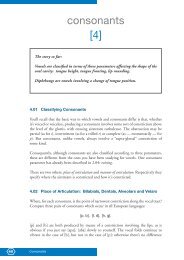PHONETICS MANUAL.indd - HumBox
PHONETICS MANUAL.indd - HumBox
PHONETICS MANUAL.indd - HumBox
You also want an ePaper? Increase the reach of your titles
YUMPU automatically turns print PDFs into web optimized ePapers that Google loves.
In some languages, the rear wall of pharynx serves as a passive articulator. The<br />
root of the tongue is pulled back towards it, causing a constriction used for certain<br />
characteristically “guttural” sounds in Arabic or Hebrew (see 4.06).<br />
Remember the difference: the larynx is a cartilaginous box immediately above the<br />
trachea; the pharynx is the cavity or “crossroads” above the larynx.<br />
2.09 Pronunciation: an Acquired Skill<br />
Two points by way of conclusion.<br />
Firstly, the structures described above are universal in humans: whatever the race or<br />
speech-community, the speech organs are the same. There are of course differences in<br />
the size and even precise shape of particular parts of the vocal tract, but differences<br />
between individuals in a given speech-community are greater than the average<br />
differences between one community and another.<br />
It follows from this that the pronunciation difficulties experienced by people learning a<br />
foreign language are due to psychological factors, not to anatomical ones. After the age<br />
of 10 or so, most people find it difficult to break away from their native sound system. So<br />
someone who finds French r, German ü or Spanish j troublesome doesn’t have anything<br />
wrong with their uvula, tongue or velum (or at least this is highly unlikely): it’s just that<br />
their brain is finding it hard to adapt to new articulatory habits. A person’s knowledge<br />
of his or her mother tongue is in no way congenital. Had you been kidnapped at the age<br />
of six months and brought up in France, Germany or Spain — or China or the Amazon<br />
Basin for that matter — you’d be speaking the local language in a totally “native-like”<br />
manner ... and no doubt having problems with English.<br />
Exercises<br />
5. Show where the following are situated on this diagram of the upper vocal tract:<br />
1. blade of tongue, 2. front of tongue, 3. velum, 4. pharynx, 5. larynx,<br />
6. uvula, 7. alveolum, 8. root of tongue.<br />
12 The Vocal Tract






